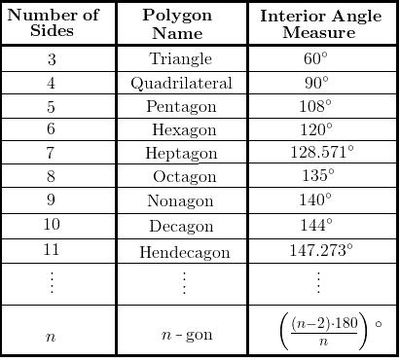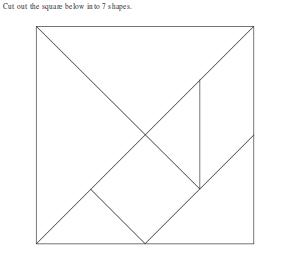Difference between revisions of "Polygons"
| Line 165: | Line 165: | ||
# This is a very old Chinese puzzle known as a tangram. | # This is a very old Chinese puzzle known as a tangram. | ||
# Cut out the square below into 7 shapes. | # Cut out the square below into 7 shapes. | ||
| − | # Cut out the 7 shapes and rearrange them to form: | + | # Cut out the 7 shapes and rearrange them to form:<br> |
| − | (a) a square from two triangles, and then change it to a parallelogram; | + | (a) a square from two triangles, and then change it to a parallelogram;<br> |
| − | (b) a rectangle using three pieces, and then change it into a parallelogram; | + | (b) a rectangle using three pieces, and then change it into a parallelogram;<br> |
| − | (c) a trapezium with three pieces; | + | (c) a trapezium with three pieces;<br> |
| − | (d) a parallelogram with four pieces; | + | (d) a parallelogram with four pieces;<br> |
| − | (e) a trapezium from the square, parallelogram and the two small triangles; | + | (e) a trapezium from the square, parallelogram and the two small triangles;<br> |
| − | (f) a triangle with three pieces; | + | (f) a triangle with three pieces;<br> |
| − | (g) a rectangle with all seven pieces. | + | (g) a rectangle with all seven pieces.<br> |
| − | (h) a kite with two traingles. | + | (h) a kite with two traingles.<br> |
| − | + | 4. Finally, put the pieces back together to form the original square.<br> | |
*Developmental Questions: | *Developmental Questions: | ||
# Were you all able to read and follow the instructions. | # Were you all able to read and follow the instructions. | ||
Revision as of 05:13, 18 December 2013
| Philosophy of Mathematics |
While creating a resource page, please click here for a resource creation checklist.
Error: Mind Map file polygons.mm not found
Textbook
To add textbook links, please follow these instructions to: (Click to create the subpage)
Additional Information
Useful websites
1. http://www.wyzant.com/resources/lessons/math/geometry/quadrilaterals/polygons . This website is good for referring to the theory regarding polygons.
Reference Books
Teaching Outlines
- Introduction to polygon
- Naming the polygons
- Characteristics of polygons.
- Types of polygons.
Concept #1. Introduction to polygons and nomenclature.
Learning objectives
- Lines intersect to form figures.
- Two dimensional closed figures can be of varied shapes.
- Plane closed figures with ≥ 3 sides are known as polygons.
- They can be defined as two-dimensional, closed, plane shapes composed of a finite number of straight sides that meet at points called vertices.
- There are a countless number of polygons.
- Because they all differ in the number of sides that they have, this results in different angle measures at their vertices.
- With the exception of the triangle and quadrilateral, all polygon names end with "gon."
- Generally polygons are named with their number of sides as prefixes. The prefix for the word "hexagon" is "hexa," which essentially means "six."
Notes for teachers
There are a countless number of polygons. Because they all differ in the number of sides that they have, this results in different angle measures at their vertices. Listed below are the names and number of sides of some polygons. The "Interior Angle Measure" column of the table only applies to regular polygons, in which all the interior angles are equal.
With the exception of the triangle and quadrilateral, notice that all polygon names end with "gon." What sets regular polygon names apart from each other are their prefixes, which speak to the number of sides that they have. For instance, the prefix for the word "hexagon" is "hexa," which essentially means "six." However, as we move down our list and the names for polygons becomes quite confusing, we need a more efficient way of naming polygons. One way is by not calling a polygon by its real name, but rather by just saying the number of sides it has, and attaching "-gon" at the end. For instance, rather than calling an 18-sided polygon an "octdecagon," we can just call it an 18-gon. Thus, a polygon with n sides is simply called an n-gon.
This information has been taken from the website :http://www.wyzant.com/resources/lessons/math/geometry/quadrilaterals/polygons
Activity No # 1. Which polygon am I ?
- Estimated Time: 30 minutes.
- Materials/ Resources needed: Laptop, geogebra file, projector and a pointer.
- Prerequisites/Instructions, if any:
- The students should know that lines intersect to form figures.
- In other words plane closed figures have atleast 3 sides.
- The intersecting points of two lines is known as a vertex and the lines are the edges/sides.
- The student should know the meaning of greek numerals uni, bi, tri ....etc.
- Multimedia resources: Laptop
- Website interactives/ links/ / Geogebra Applets
- Process:
- The teacher can tell the students that they are surrounded by many different kinds of shapes every day.
- Many of these shapes are two-dimensional plane figures.
- Plane figures are flat. They can be closed or not closed.
- Plane figures made up of three or more closed line segments are polygons.
- Each line segment of a polygon is a side. Polygons are classified and named based on the number of sides.
- Developmental Questions:
- How many vertices, sides and angles does this figure have ? Name the figure.
- What is the point of intersection of two lines called ?
- What parameters do you identify in each figure ? (side, vertex, angle, plane surface and area )
- What can you say about the number of vertices and the number of sides in each figure ?
- Which figure would you think will be formed if the number of sides is increased indefinately.
- Evaluation:
- What determines the side or edge of the figure ?
- Are the students able to corelate the names with the number of sides ?
- Are the students able to appreciate the nature of shapes formed with each increasing side?
- Students can discuss angle sum property in each case by dividing the figure into triangles or quadrilaterals.
- Question Corner:
- A hexagon is a polygon with _________ angles.
- Is circle a polygon ?
- What is a polygon with 12 sides called ?
- You have a collection of sides from triangles and decagons. The total number of sides is 100 and you have 4 decagons. How many triangles do you have ?
Activity No #
- Estimated Time
- Materials/ Resources needed
- Prerequisites/Instructions, if any
- Multimedia resources
- Website interactives/ links/ / Geogebra Applets
- Process/ Developmental Questions
- Evaluation
- Question Corner
Concept #2. Characteristics of polygons
Learning objectives
Notes for teachers
Activity No #
- Estimated Time:
- Materials/ Resources needed:
- Prerequisites/Instructions, if any:
- Multimedia resources:
- Website interactives/ links/ / Geogebra Applets:
- Process/ Developmental Questions:
- Evaluation:
- Question Corner:
Activity No #
- Estimated Time
- Materials/ Resources needed
- Prerequisites/Instructions, if any
- Multimedia resources
- Website interactives/ links/ / Geogebra Applets
- Process/ Developmental Questions
- Evaluation
- Question Corner
Concept #3. Types of polygons
Learning objectives
- There are several polygons.
- Polygons are classified by considering their angle measures and side length measures.
- If a polygon's angles and sides are equal, then the polygon is called a regular polygon.
- If the measures of a polygon's angles or side lengths differ, then the polygon is called an irregular polygon.
- Primary shapes can be combined to form composite polygons. (This knowledge will help while deducing area formulae for complex figures which would be derived by splitting them into primary figures.)
Notes for teachers
Activity No # Tangram - Building polygons
This activity has been taken from the website :http://www.cimt.plymouth.ac.uk/projects/mepres/allgcse/bs7act1.pdf
- Estimated Time : 40 minutes.
- Materials/ Resources needed: Chart papers, scissors, pencil, scale.
- Prerequisites/Instructions, if any
- The students should have understanding of basic shapes like square, rectangle, parallelogram, triangle and trapezium.
- They should be able to draw mentioned shapes accurately and cut exactly on boundaries.
- Multimedia resources
- Website interactives/ links/ / Geogebra Applets
- Process:
- This is a very old Chinese puzzle known as a tangram.
- Cut out the square below into 7 shapes.
- Cut out the 7 shapes and rearrange them to form:
(a) a square from two triangles, and then change it to a parallelogram;
(b) a rectangle using three pieces, and then change it into a parallelogram;
(c) a trapezium with three pieces;
(d) a parallelogram with four pieces;
(e) a trapezium from the square, parallelogram and the two small triangles;
(f) a triangle with three pieces;
(g) a rectangle with all seven pieces.
(h) a kite with two traingles.
4. Finally, put the pieces back together to form the original square.
- Developmental Questions:
- Were you all able to read and follow the instructions.
- Name and point the different shapes in the figure.
- Name the dimensions of each shape.
- Evaluation:
- Were the students able to identify the types of polygons based on the number of sides.
- What type of two triangles would you need to form a square ?
- Question Corner:
- What are the characteristic properties of each shape: square, rectangle, triangle, parallelogram and trapezium ?
- What did you learn from this activity ?
Activity No #
- Estimated Time:
- Materials/ Resources needed:
- Prerequisites/Instructions, if any:
- Multimedia resources:
- Website interactives/ links/ / Geogebra Applets:
- Process/ Developmental Questions:
- Evaluation:
- Question Corner:
Activity No #
- Estimated Time
- Materials/ Resources needed
- Prerequisites/Instructions, if any
- Multimedia resources
- Website interactives/ links/ / Geogebra Applets
- Process/ Developmental Questions
- Evaluation
- Question Corner
Hints for difficult problems
Project Ideas
Math Fun
Usage
Create a new page and type {{subst:Math-Content}} to use this template

